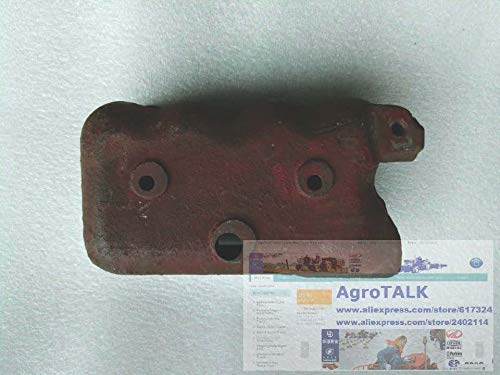Yes, switches are very noisy, and unless "de-bounced," spurious key presses are pretty much inevitable. There are two approaches to debouncing, hardware or software. The hardware approach is to add a small capacitor between the signal and ground (try .001uF to .01uF or so) - this assumes a typical pull-up situation, either via a pull-up resistor or internal pull-up on the Arduino pins. The software approach is to implement a delay each time a key press is detected before reading any other key presses. Be sure that the delay does not interfere with the timing of the stepper routines.
You are using an out of date browser. It may not display this or other websites correctly.
You should upgrade or use an alternative browser.
You should upgrade or use an alternative browser.
Arduino Rotary Table for Dummies
- Thread starter bmac2
- Start date

Help Support Home Model Engine Machinist Forum:
This site may earn a commission from merchant affiliate
links, including eBay, Amazon, and others.
McRoth
Member
I think I got it. My box has a big aluminum plate that the keypad and screen are mounted to. I ran a ground from it to the arduino and so far it's behaving.
I was wondering why no one else was having similar issues & this is probably why.
Mike
I was wondering why no one else was having similar issues & this is probably why.
Mike
Hi all i have built one of these and it works well. What i want to do is add a 40kg servo to the system to unlock the dividing head clamp. I would like to have a software interlock which stops the advance of the head having to lock and unlock the head
Would this be possible
Thanks Dave
Would this be possible
Thanks Dave
- Joined
- Feb 26, 2020
- Messages
- 658
- Reaction score
- 408
What do I have to immagine when I hear "40 kg Servo"?Hi all i have built one of these and it works well. What i want to do is add a 40kg servo to the system to unlock the dividing head clamp. I would like to have a software interlock which stops the advance of the head having to lock and unlock the head
Would this be possible
Thanks Dave
A 40 kg airplane servo normaly used in large model aircraft. 40 kg may be an overkill i can always use 20 kg servos. These will pull/push their rated weight and are very handy. So i plan on a mounting bracket on the dividing head and a lever to the clamp from the servo. I imagagine an interupt in the software to lock/unlock the servo so it cant advance the program untill unlocked then program rotates stepper motor. When it has reached the number of steps servo is moved to lock the dividing head. It might work i just need help
Dave
Dave
dazz
Well-Known Member
- Joined
- May 21, 2016
- Messages
- 171
- Reaction score
- 40
Hi
If there is any chance that there will be damage if the lock is NOT disengaged, then you should use a hardware based interlock as well as software.
You want something that will detect a hardware fault so the software can confirm that the lock is off/on, or something else. The something else could be a piece of swarth stuck between something.
In short, you need sensors to provide feedback to confirm the hardware is doing what the software is expecting.
If there is any chance that there will be damage if the lock is NOT disengaged, then you should use a hardware based interlock as well as software.
You want something that will detect a hardware fault so the software can confirm that the lock is off/on, or something else. The something else could be a piece of swarth stuck between something.
In short, you need sensors to provide feedback to confirm the hardware is doing what the software is expecting.

$188.98
TM NEXDYNAMI RE41157 Water Pump Compatible With/Replacement For/John Deere 6200 7400 6300 6600 6500 6400 7220 7600 7200 RE41157
VIVID MARKET CORPORATION

$426.53
DM14 Engine Build Kit, Metal Engine Build Model Great Metal Material for Engineer for Factory
Easoger Official

$649.00
$699.00
FoxAlien Masuter Pro CNC Router Machine, Upgraded 3-Axis Engraving All-Metal Milling Machine for Wood Acrylic MDF Nylon Carving Cutting
FoxAlien Official

$99.99
AHS Outdoor Wood Boiler Yearly Maintenance Kit with Water Treatment - ProTech 300 & Test Kit
Alternative Heating & Supplies

$94.99
$109.99
AHS Woodmaster 4400 Maintenance Kit for Outdoor Wood Boiler Treatment
Alternative Heating & Supplies

$39.99
$49.99
Sunnytech Low Temperature Stirling Engine Motor Steam Heat Education Model Toy Kit For mechanical skills (LT001)
stirlingtechonline

$29.95
Competition Engine Building: Advanced Engine Design and Assembly Techniques (Pro Series)
Amazon.com Services LLC

$109.99
AmTech300 - Boiler Treatment Professional Strength (Rust Inhibitor For Outdoor Wood Boilers)
Alternative Heating & Supplies

$156.90 ($1.40 / oz)
Replacement Combustion Chamber Kit, Burnham V8 and V8H, 1-6 Sec, 108136-01, 1129
Lynn Manufacturing

$40.02
$49.99
Becker CAD 12 3D - professional CAD software for 2D + 3D design and modelling - for 3 PCs - 100% compatible with AutoCAD
momox Shop

$190.00
$254.99
Genmitsu CNC 3018-PRO Router Kit GRBL Control 3 Axis Plastic Acrylic PCB PVC Wood Carving Milling Engraving Machine, XYZ Working Area 300x180x45mm
SainSmart Official
dazz
Well-Known Member
- Joined
- May 21, 2016
- Messages
- 171
- Reaction score
- 40
I haven't looked at the circuit for a long time but one option might be to include interlocks that detect fault conditions external to the Arduino.
Another option is to use a different controller.
Yet another option is to not include any feedback/interlocks with the greater risk of damage if something goes wrong.
Another option is to use a different controller.
Yet another option is to not include any feedback/interlocks with the greater risk of damage if something goes wrong.
- Joined
- Feb 26, 2020
- Messages
- 658
- Reaction score
- 408
Question is: How many sensors and I/O do you need?I dont think there would be enough i/o left on the arduino to add any sensors. It would have to come from key switchs and software
Dave
Make a plan, test the mechanics, arrange the electrics, then change program. -> Done!
A3, A2, A1 and A0 are free.
Digital I/Os 11, 12 and 13 are unused.
Digital I/Os 0 and 1 might be used by the serial output during programming
The memory is about 1/3 rd full with what was the typical code roaming around.
You can program what you like into the thing. Worst case! You go from the Arduino UNO to an Arduino MEGA which would change the number of digital I/O from 14 to 54 and the Analog pins from 6 to 16?
How do you intend to arrange the servo operated lock?
You don't want the servo to be under load in either the locked or unlocked condition - it will draw a lot of current and quickly overheat.
I would suggest an over-centre cam of some kind and code to drive the servo to desired position, then back off a little to ensure that it is unloaded.
You don't want the servo to be under load in either the locked or unlocked condition - it will draw a lot of current and quickly overheat.
I would suggest an over-centre cam of some kind and code to drive the servo to desired position, then back off a little to ensure that it is unloaded.
This post from Home Made Tools, may be of interest for a Rotab brake;
https://www.homemadetools.net/forum/motorized-rotary-table-96858
https://www.homemadetools.net/forum/motorized-rotary-table-96858
I have been helping someone with using a servo like you describe with the mechanics for a different purpose. Numerous problems with powering from the arduino. I did not do the programming so cant speak to that. I think there are probably better ways to mechanically design a system for your purpose. The arduino can easily pick the positions and send the command signals to do what you need to do but it would be good to have a solid mechanical lock for things you are machining on. Those servos seem a bit fragile.Hi all i have built one of these and it works well. What i want to do is add a 40kg servo to the system to unlock the dividing head clamp. I would like to have a software interlock which stops the advance of the head having to lock and unlock the head
Would this be possible
Thanks Dave
Similar threads
- Replies
- 10
- Views
- 22K
- Replies
- 40
- Views
- 26K
- Replies
- 139
- Views
- 79K



























![MeshMagic 3D Free 3D Modeling Software [Download]](https://m.media-amazon.com/images/I/B1U+p8ewjGS._SL500_.png)



























